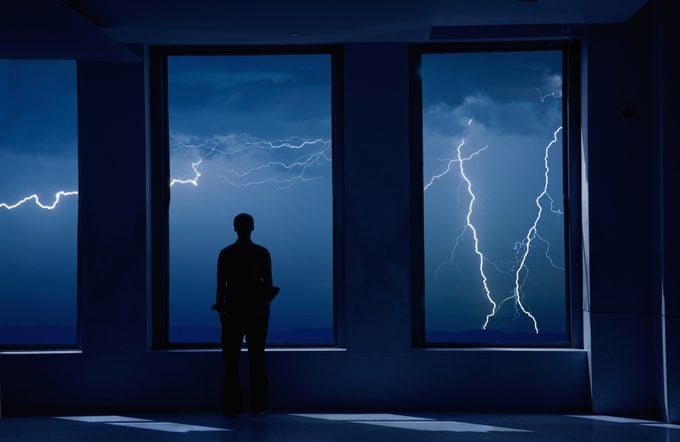Here’s Why Showering During a Thunderstorm is a Terrible Idea
Updated: Sep. 14, 2022
It's not a myth, but it's very rare. Experts share why you should avoid showering during a thunderstorm, and reveal other chores you'd be smart to skip until the storm passes.
Can you shower during a thunderstorm?
There are lots of things you shouldn’t do in a thunderstorm; head inside, avoid using electronics, stay away from the windows. But if you’ve ever heard the old advice that you should avoid showering during a thunderstorm because you could get an electric shock from the lightning, you might have rolled your eyes. It turns out, though, that this myth is actually true, and has happened—although it’s very rare.
“Any use of plumbing or water by a home’s occupants along the path of the lightning would be taking a lightning safety risk,” says Jeffrey Peters, National Weather Service (NWS) Lightning Safety Expert and Severe Weather Program Coordinator.
But how can electricity from lightning get inside your house? And if bathing is dangerous, what about washing dishes or your hands, or even going to the bathroom? We asked some lightning experts what you should avoid—and any excuse to put off doing the dishes is fine by us!
10 Tips for Staying Safe in a Thunderstorm
Can lightning travel through water?
Yes, and this is why the lifeguards always call you out of the pool at the first crack of thunder. However, pure water is not a good conductor of electricity, says Randy Adkins, a meteorologist in the forecasting department at AccuWeather. “But the water we all consume isn’t pure—it contains dissolved minerals, and it is these minerals that serve as a conductor for electricity,” he says.
The danger of using water indoors is also due to the pipes. “Metal plumbing pipes transmit electricity, and water can transmit electricity, as most people know,” says lightning expert Mary Ann Cooper, MD, professor emerita of emergency medicine at the University of Illinois and the current managing director of the African Centres for Lightning and Electromagnetics Network.
Plus, “copper and steel pipes are excellent conductors of electricity, as are most metals, due to the physics and chemistry of these materials,” Adkins says. If you remember what you learned in high school science, metals have electrically charged particles called electrons that can move about easily. “When provided with an electrical voltage, they will readily move and carry an electrical current,” Adkins says. This process, called conduction, allows the electricity of the lightning to move through the metal as well as the water, Peters says.
Get The Healthy @Reader’s Digest newsletter

How does lightning get inside your house?
“Lightning’s path from the cloud to the ground is one of least resistance: When lightning strikes a house, it can travel toward the ground through the plumbing, wiring or phone lines,” Peters says. In addition to actually striking your house, it’s possible that if it hits somewhere nearby, it could still make its way inside.
“Lightning that strikes outside, nearby one’s home, can pose a danger with the lightning traveling by way of conduction underground through the metal pipes and water into your home,” he says.
It’s hard to say how far away a lightning strike could potentially be a danger to someone inside a house, though. Adkins cites cases where lightning has been observed to travel 60 to 100 feet—but that’s outside. “For someone indoors, it is rare for a lightning strike that far away to cause harm, even though it can travel through electrical wiring and plumbing lines located outside of the home,” he says. He also points to the fact that lightning typically enters a house from striking the roof.
Dr. Cooper also says it’s difficult to tell how far away a lightning strike would be a danger to someone inside a house. “There is no simple answer to this, as it depends on the strength of the lightning strike, the moisture of the ground and many other factors,” she says. If it gets inside, though, the lightning can continue to travel through the plumbing and the water indoors—and if you’re touching that water by showering during a thunderstorm or otherwise, the lightning can travel through you as well.
10 Sneaky Backyard Dangers You Should Know
So I should hold off on using the sink or showering during a thunderstorm? What about the toilet?
Peters and Adkins both say they’d advise against using water inside during a lightning storm, including showering during a thunderstorm, taking a bath, doing dishes or even washing your hands, as these activities increase your risk of getting a jolt.
“The danger posed with the lightning’s electricity—the average lightning bolt carries 30,000 amps of current—and the quick occurrence of lightning, in less than a second, suggest it’s best to avoid using water inside your home during a thunderstorm,” says Peters. The sink full of dishes can wait—usually the referenced guideline is 30 minutes after the storm passes, Adkins says.
You’re probably safe going to the bathroom, though. “Using the toilet is of some small risk, but it isn’t as high as being in the shower or washing your hands for the simple fact that you are not actually immersed in the water—and if you are then things are going horribly wrong!” Adkins jokes.
Home Cleaning Tips Straight From the CDC
Is there anything else I shouldn’t do inside during a thunderstorm?
Anything that uses water and electricity should be avoided during a thunderstorm. “Since wiring is another path that lightning takes to the ground in homes, ice makers and dishwashers pose a lightning safety risk due to the wiring and plumbing,” Peters says.
Any electrical appliances are also a risk, because your home’s electrical system could be a conduit for the lightning. “Corded phones are the greatest danger since the receiver is so close to one’s head,” Adkins says. “A cordless phone isn’t an issue, provided you are not right next to the base station; cell phones, when used indoors, are fine as well. Using a computer is a potential hazard unless you are using a laptop while not plugged in.”
What can I do to protect my home against lightning strikes?
A new type of plastic plumbing called PEX may be somewhat safer than copper or steel pipes in theory, Adkins says. “But I cannot imagine this would make a significant difference in terms of overall risk,” he says. A better choice for protection? “A house that has an installed lightning protection system—think lightning rods—stands a much better chance of having a lightning strike take a safer path to ground, as opposed to traveling through a house’s wiring or plumbing.”
How many people are affected by lightning strikes inside the home?
According to Peters, there have been injuries reported of people using or being near plumbing or water inside their home, but exact numbers are not available.
“Lightning fatalities data collected by the NWS indicate there hasn’t been any lightning fatalities directly related to indoor plumbing in the last 15 years,” he says. There was one case since 2006 of a person who was killed by lightning while inside—but that individual was sitting by a window, not using water.
Still, it’s not just being killed you should worry about, as only 10% of all lightning strikes are fatal. “Although it’s reportedly rare to be killed by lightning inside your home when using water, some who are injured are forced to cope with life-long health issues including neurological problems and pain syndromes,” Peters says.
According to the Centers for Disease Control and Prevention (CDC), one-third of all lightning injuries (300 to 400 Americans struck per year) occur indoors. (Again, statistics specifically involving water are hard to come by.) Your total risk each year of being struck by lightning is more than one in a million, according to the NWS.
Lightning strikes while using water inside or showering during a thunderstorm are definitely rare, “but then, you don’t get hit by a truck very often either, but you should try to avoid both of these,” Dr. Cooper says.
How to Save Your Own Life in 12 Scary Emergencies
I’m a little scared now. Can you put this risk in perspective?
Things we do every day, like driving, pose a much greater health risk. Even just in terms of lightning itself, the bigger danger is outside.
“Being outdoors increases the risk of being struck, and the risk of death is substantially higher for those struck while outdoors,” Adkins says. “While golf has long been looked at as the riskiest outdoor activity, it is actually fishing that has proven to be the deadliest.”
Making good choices, such as heeding the old saying, “when thunder roars, go indoors,” can reduce your risk. Dr. Cooper says that lightning is actually much more of a threat in tropical areas in the developing world, where there is more lightning and fewer safe places to go.
But when it comes to assessing risk, we don’t always think rationally. “The risk of serious injury or death from a lightning strike while showering during a thunderstorm is lower than the risk of falling while in the shower, or on the bathroom floor when exiting the shower,” Adkins says. Still, if you’re concerned about being struck by lightning while indoors, there’s no real reason not to avoid water or showering during a thunderstorm—even if it’s rare to be affected.




















